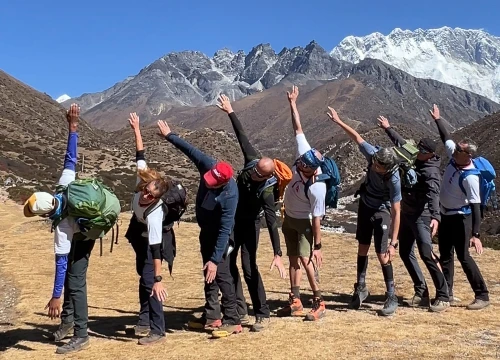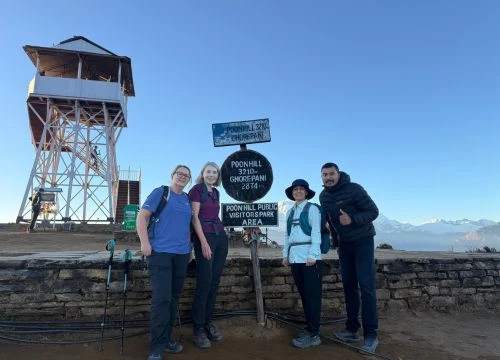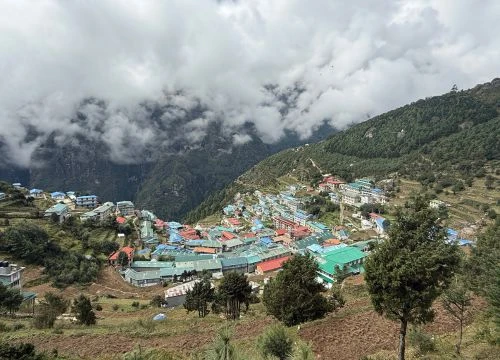What Exactly Is Rainbow Valley?
 When people hear “Rainbow Valley,” they often imagine a vibrant natural landscape. A land filled with flowers or colorful rainbows arching across the sky. But Everest’s Rainbow Valley is quite different - somber yet striking. The term “Rainbow Valley” refers to a section of the Mount Everest Death Zone above 8,000 meters. A place where the remains of climbers who lost their lives still rest. This area is a part of the Everest Death Zone - the extreme altitude zone where oxygen is dangerously low and human survival is severely challenged.
When people hear “Rainbow Valley,” they often imagine a vibrant natural landscape. A land filled with flowers or colorful rainbows arching across the sky. But Everest’s Rainbow Valley is quite different - somber yet striking. The term “Rainbow Valley” refers to a section of the Mount Everest Death Zone above 8,000 meters. A place where the remains of climbers who lost their lives still rest. This area is a part of the Everest Death Zone - the extreme altitude zone where oxygen is dangerously low and human survival is severely challenged.
Why it’s called ‘Rainbow Valley’? Climbers who died left behind their bright-colored jackets, tents, and equipment, which now remain scattered throughout the area. With the white snow and ice contrasting sharply, the splashes of color look like an important “rainbow” along the mountains. Rather than being captivating, it acts as a somber memory that brings attention to the pursuit of a dream and the bodies on Everest that remain as tragic memorials.
Location and Geography: Where Is Rainbow Valley?
Though there is nothing like Rainbow Valley as tourists stop on standard maps, it is known along the trekking route on Everest’s northeast ridge. It is one of the most common ways climbers try to reach the summit from Tibet. At more than 8,000 meters (26,247 feet), the air thins drastically, temperatures plunge, and dangers rise sharply. The Everest Death Zone exists here because the air becomes so thin that a person’s body can’t absorb enough oxygen for even basic survival.
The cold, dry climate preserves everything exposed in this area in remarkable condition. Time appears to have frozen, and colorful gear now lies grouped beside the icy mountains. The bright colors sharply contrast with the bleak, frozen landscape, which is why people named the place Rainbow Valley Everest.
The Story of Francys Arsentiev: Everest’s “Sleeping Beauty”
One of the famous stories of the Rainbow Valley’s history is the story of Francys Arsentiev, the American climber who was nicknamed the “Sleeping Beauty of Everest”. She shows what climbers deal with as they reach the dangerous Death Zone Everest and tackle the risks of Mount Everest.
Francys reached the summit of Everest in 1998 without using additional oxygen, becoming the first American woman to do so which demonstrated her strong endurance. While descending, Suzanne and her husband Sergei got separated. Because of the fatigue and high altitude caused, Francys felt very tired most of the time.
More climbers noticed that she was lying there in the snow, near the summit. Even though rescuers made many attempts to save her, she ultimately died where she fell. Because of her gentle temperament, the color of her jacket and her quiet features, her climbing friends gave her the nickname Sleeping Beauty. The book illustrates how easily the mountain’s conditions can change and the close connection between success and failure.
A Brief History Behind Rainbow Valley

Soon after Edmund Hillary and Tenzing Norgay’s triumph in 1953, numerous climbers started trying to reach Everest’s summit. Mountaineers come from many countries to climb it, but the mountain can be very dangerous.
More than 300 people have lost their lives on Everest, most of them in the Death Zone, where rescue is almost impossible. Rescue teams couldn’t remove many of the bodies of Everest climbers because doing so would be extremely dangerous and costly.
The various jackets, tents and supplies found on the mountain now stand for people’s determination, struggle and final loss. The icy rainbow formations pay respect to the mountaineers who faced the mountain’s challenges willingly.
Understanding Everest’s Death Zone: Why Is It So Dangerous?

At 8,000 meters above sea level, the Death Zone begins and here the amount of oxygen available is only one-third of what people find at lower altitudes. A severe drop in oxygen levels greatly reduces how the body functions.
While resting, climbers face great tiredness, poor judgment and problems staying focused. There are scenarios where hallucinations occur. Having no extra oxygen or a quick way down, a person survives for only a few hours in this area.
In addition, weather within the Death Zone can often be very unpredictable. During winter,−30°C is common and strong gusts of wind can try to take climbers off their feet. Sometimes, unexpected storms can leave teams stranded for a long time which puts rescuers in real danger.
Poor air density at those heights prevents helicopters from traveling, so climbers must depend entirely on themselves and others in their team. The harsh conditions cause many misadventures and leave bodies on Everest preserved in the same locations where climbers fell.
The Safety Challenges of Climbing Mount Everest
- Many risks for climbers make climbing Mount Everest difficult both physically and mentally.
- If you get Altitude Sickness, you might experience a headache, nausea, dizziness and in some serious situations, your brain and lungs can swell and this can lead to death.
- Because of how quickly it can change, the weather might be peaceful in the morning and harsh in the afternoon.
- Large dangers are presented by the Khumbu Icefall, uneven terrain and falling snow.
- When many climbers reach the Death Zone together, queuing times can be long which may result in running out of oxygen and other dangers.
- Climbers sometimes meet with accidents when they act carelessly, give in to their own ambitions, or feel pressured by peers.
- Being successful on Everest calls for the right timing, understanding how nature works and knowing yourself well. It is as important to decide when not to move forward as it is to keep going.
Frequently Asked Questions About Rainbow Valley and Everest’s Death Zone
#1 Is Rainbow Valley a real place?
Ans: Yes, people call the area in the Death Zone on Everest 'Rainbow Valley' because it contains many climbers’ belongings.
#2 Why aren’t dead bodies removed from Everest?
Ans: Saving someone after an avalanche is very hard because the environment is harsh, air is scarce, and the area is steep. In most cases, it costs a lot, and not all families can pay for it.
#3 Can tourists visit Rainbow Valley?
Ans: Only people who have worked at climbing for a long time can climb to the top. Tourists rarely visit Everest, and climbing parties stay only as long as necessary out of respect for the mountain.
#4 How do climbers prepare for the Death Zone?
Ans: By participating in extensive training, physical adjustment, using oxygen gear, and clocking their activity. Still, being prepared doesn’t eliminate the high level of risk faced.
Conclusion: The Powerful Legacy of Rainbow Valley
Rainbow Valley is simply much more than a location after Everest base camp. It serves as a sign of the mountains’ character and the eagerness of humans to accomplish something huge. Nonetheless, it shows that it is very important to recognize just how dangerous natural disasters are. If someone is an explorer, visiting Rainbow Valley Everest lets them grasp the importance of setting ambitions high, still showing respect for the boundaries around them. As the highest mountain on earth, Mount Everest also portrays courage, weakness and the dangers people face on expedition to the summit.


 When people hear “Rainbow Valley,” they often imagine a vibrant natural landscape. A land filled with flowers or colorful rainbows arching across the sky. But Everest’s Rainbow Valley is quite different - somber yet striking. The term “Rainbow Valley” refers to a section of the Mount Everest Death Zone above 8,000 meters. A place where the remains of climbers who lost their lives still rest. This area is a part of the Everest Death Zone - the extreme altitude zone where oxygen is dangerously low and human survival is severely challenged.
When people hear “Rainbow Valley,” they often imagine a vibrant natural landscape. A land filled with flowers or colorful rainbows arching across the sky. But Everest’s Rainbow Valley is quite different - somber yet striking. The term “Rainbow Valley” refers to a section of the Mount Everest Death Zone above 8,000 meters. A place where the remains of climbers who lost their lives still rest. This area is a part of the Everest Death Zone - the extreme altitude zone where oxygen is dangerously low and human survival is severely challenged.




